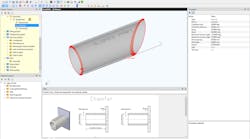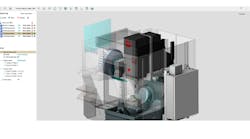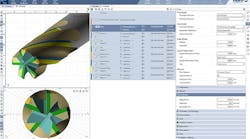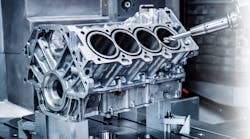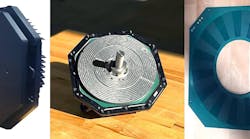In talking to the people who run this year’s 10 Best Shops, the same patterns emerged that we’ve seen in the 10 Best Shops in the past two years.
All of the shop managers recognize the critical role that computer software has in making their operations successful.
All of them incorporate the power of their computer software into a deliberate program of continued productivity improvement.
And, all of the shops have taken special approaches in choosing and using software that is appropriate for their operations.
The use of computer software in a machine shop can be divided into two main functions.
One is to run the business; the other is to run the machines.
Business software can be used to improve the productivity of order entry, purchasing, accounting, shop scheduling, work order control, inventory control, materials resource planning, payroll and shipping and receiving.
The software used by the 10 Best Shops spans the spectrum from a fullblown Enterprise Resource Planning (ERP) system that is supported by in-house application programmers to a shop that uses only Excel spreadsheets, Microsoft Scheduler and Peachtree Accounting for Manufacturers.
About 10 years ago, B&B Manufacturing in Valencia, Calif., had to implement a full ERP system to get a large production contract. B&B Manufacturing has about 220 employees.
The shop bought an ERP package from Mfg Software in Orange County, Calif. that included the source code to the programs. It hired applications programmers and began to implement the system.
“Of course when we first brought the system online, everyone said ‘Pull the plug. Turn it off. Make it go away, it’s terrible.’,” Jeff Lage, vice president of B&B Manufacturing, said.
“Now we can’t live without it. Two or three years ago we rolled out touch screens on the shop floor. Anyone can look at work orders and scheduling.
“Every work center gets its work orders scheduled directly from the ERP system, so you don’t have to talk to the boss to find out what to do next, you just enter your work center number through the touch screen and it tells you your next job and the other jobs coming down the line to you.
“We also can grab sketches and drawings, send emails right from the shop floor, and request a tool change that gets delivered directly to the work cell,” Lage said.
“We use bar codes and scanners throughout the business,” Lage added.
“For example, purchasing gets a needs report that has the part numbers and bar codes on it. The ERP system is so streamlined that it only takes about two minutes to issue a PO.”
“We’ve also rolled out an eCommerce module to our supply chain.
“Our suppliers can look online, dialed right into our ERP system, when they get an email for a new order. They click on the link in the email, and it takes them right into our inventory position, our forecast, hard orders, and what they have due in. They can even get an accounts payable aging that will tell them when they are going to get paid.”
On the machine control side, B&B uses CATIA for almost all of its Computer Aided Design (CAD) work and as a frontend to Mastercam for machining. The shop also uses Vericut to verify tool paths coming out of Mastercam, and PC-DMIS for its nn CMM programming needs.
The decision to go with CATIA was customer driven. B&B recently was approved by Boeing for its Digital Product Definition program. In addition to working in aerospace, the shop also supplies parts to highperformance auto racing teams such as Honda Racing and other companies that use CATIA.
One area the shop is focusing on for productivity improvement is inspection.
It uses tools such as point cloud to overlay models from Mastercam to find where the variances are. Doing that is much quicker than trying to do point-by-point inspection because it produces an overlay of 100 percent of the part, and it gives the shop the ability to identify problem areas. Unfortunately, point cloud software doesn’t solve all of the shop’s problems and it is looking for other ways to reduce CMM programming.
Lage said one solution might be the new CMM automation software from PAS Technology.
At the other end of the spectrum from B&B is Rose Industries, a seven person shop that does sophisticated machining for aerospace, Department of Defense, high-end commercial and medical customers.
All of this shop’s business applications are handled by Peachtree Accounting for Manufacturers, Excel spreadsheets and Microsoft Scheduler.
Machine control is done using AutoCAD LT and, instead of a third party CAM package, the shop uses the software that comes with their Hurco machines.
“The Hurco software is amazing,” Bob Rose, vice president and treasurer of Rose Industries, said.
“We get jobs up and running in as little as an hour. Even complex 5-axis jobs are easy with the Hurco on-board software. I believe in keeping things simple. No time clocks, no bar coding, time is kept on pieces of paper, job cost is done on the same paper. We’ve looked at Exact JobBOSS and it may have some advantages in the long run, but the buy-in is high for us,” Rose said.
Hamill Manufacturing’s use of software is between B&B and Rose Industries. Hamill wrote its own ERP system, and also uses an Apple Macintosh network instead of the more common Windows based computers.
“We wrote our own system about 15 years ago, and it has been evolving ever since,” John Dalrymple president of Hamill, said.
“We have 112 people working here, and we have hit a point where we have outgrown the system and expect to replace it with a purchased system next year. At that point, we will incorporate bar codes and scanners as much as possible,” he said.
Hamill uses AutoCAD Inventor and Mastercam and has been working with 3D solid models for more than eight years, nearly 70 percent of the 3D models that Hamill works with come from its customers. The shop also uses Vericut to verify the Mastercam tool paths.
Both Diablo Precision and Concept Components use E2 Shop System software from Shoptech, Diablo has used the E2 Shop System for eight years, and Concept Components has used the software for about a year.
“We don’t use E2’s scheduling module because our scheduling is too dynamic for it,” Conor Kelly, president of Diablo Precision, said.
“Our scheduling changes throughout the day, and we may have up to 250 jobs across 5 screw machines. So we use Excel for our core scheduling. We also use bar coding to keep track of everything.
“I think what most people overlook in using their ERP software is that there is a lot more data in the database than most people ever look at.
“We use it for historical analysis to identify localized production bottlenecks that interfere with our ability to get jobs through our shop. How long a job is taking on a machine is only a portion of how well the job gets through the shop, and the larger you grow the harder it is to see things,” Kelly said.
As an example, he said the shop could have a guy washing parts who is fast but not as thorough as he should be.
“The next thing you get is charges from the plater because they had to add an extra step in their process to clean off what your guy didn’t. You are getting that charge because you are missing a step in your own process. The stored data can alert you to that problem. You just have to take the time to look,” Kelly added.
Diablo Precision is using Mastercam software, and it is adding Esprit software to its package.
James McGuigan, owner of Concept Components, integrated E2 software into his business a year ago. He started with his office procedures to make route sheets and to do planning, then the shop integrated scanning of documents so that all of the paperwork related to a job could be logged in.
“Our next step is installing bar coding machines on the floor,” McGuigan said.
“Each year we plan to build off the system. We ran a very simple work model for years, but have been pushed by some of our larger customers. We now are getting to the floor, which we thought was the least of our problems. We have good quality and good workflow. Now we are able to get good costing on the parts we make and are focusing on becoming ISO 9000. E2 is a phenomenal step up from the manual system we used to use,” McGuigan said.
Concept Components uses Mazak machines. The shop uses the onboard software that is provided with the machines, and it also has a software package from SolutionWare Corp. for offline programming.
The shop also uses Exact Software’s JobBOSS , Bowen and Groves’ M1 ERP system and ProfitKey International’s ERP system business control software packages. All of those packages are Microsoft Widows based.
Not all of the shops have CMM machines, but those that have them are looking for ways to improve CMM programming productivity.
The most commonly used CAM software is Mastercam, but several of the Best Shops also use Unigraphics, CATIA and Surfcam, and several use AutoCAD LT and SolidWorks computer-aided design programs. The Vericut program is the most popular tool path verification program these shops are using.
Half of the shop managers said they are actively looking for software that would help them to be more productive, and all of them said that business control software is a critical, cost effective part of their pursit for higher productivity for their shops. That fact - the use of business control software - is universal, and did not depend on the size or complexity of the business or the markets that the shop serves, although several of the managers said that their larger customers have pushed them to upgrade their information reporting and controls.
In several shops, the managers said they see their existing computer and software systems being overrun by the increased demands that come from higher sales and growth and that better control and reporting is the only way to manage that growth and to be prepared for more business.



